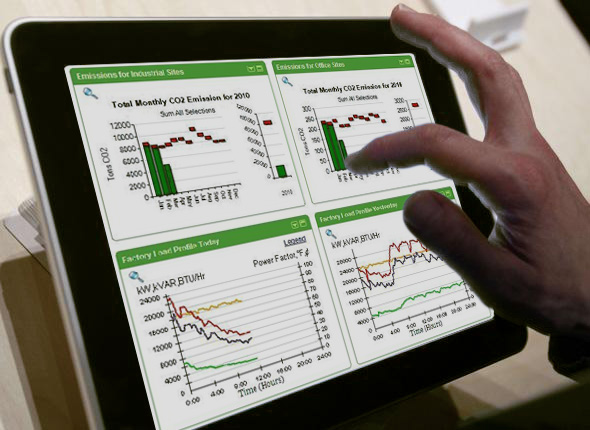Jim Wilson thinks that, in their haste to make their schools modern and efficient, some school districts are installing energy management systems that are overtaxing the ability of their maintenance staffs.
Wilson owns JFW Inc., a 25-year-old project management company in Gaithersburg, Md. Most of the K-12 work he does is with private schools like Sidwell Friends, the Quaker school that President Obama’s daughters attend. Wilson says that Sidwell’s middle school has 3,000 contact points that have to be monitored, which puts a significant burden on the facility’s maintenance staff.
He says energy codes keep raising the complexity level of what’s being installed. Maintenance crews are having trouble keeping up with EMS technology that has jumped by leaps and bounds over the past 10 years. “We didn’t have all of these [air exchange] requirements that we do now,” he says.
Wilson recounts one school’s head of maintenance who was so flummoxed by the facility’s systems that he operated the building as if it were occupied 24/7 so he didn’t have to deal with the controls. “I got a call from the school asking why its electric bills were running sky high,” says Wilson.
Jim Deluge, a Project Executive with Turner Construction, believes that maintenance staffs have a responsibility to “catch up” to the sophistication level of these new EMS systems. On the flip side, HMC Architects’ Sandy Kate thinks problems could be reduced if maintenance staff were included in early planning meetings before construction begins.
School district officials who recognize this potential problem but still want state-of-the-art operating systems will sometimes outsource the monitoring. DRL Group’s Jim French says his firm’s engineers have the ability to remotely monitor a client’s systems and let that school know almost immediately if anything’s askew.
“You have to be careful not to get too exotic,” says Fanning Howey’s Chuck Tyler. The design firm recently worked with a school district in Belleville, Mich., that demanded the systems for a 320,000-sf high school be simple enough for the district’s current maintenance personnel to manage.
Wilson contends that some schools simply don’t need the high-octane systems they specify. One project he worked on called for a $180,000 EMS. What ultimately got installed, he says, was a $40,000 system “that can do pretty much what’s needed in the building” and matches the skill set of the maintenance team.
When school districts demand the latest and greatest, they need to think about how those choices will impact the district’s facilities employees. On one recent project in Connecticut, Wilson had the contractor conduct six months of training sessions for the maintenance staff. “You can’t learn this stuff in two days of classes.”
Related Stories
| Jul 19, 2013
Renovation, adaptive reuse stay strong, providing fertile ground for growth [2013 Giants 300 Report]
Increasingly, owners recognize that existing buildings represent a considerable resource in embodied energy, which can often be leveraged for lower front-end costs and a faster turnaround than new construction.
| Jul 19, 2013
Best in brick: 7 stunning building façades made with brick [slideshow]
The Brick Industry Association named the winners of its 2013 Brick in Architecture Awards. Here are seven winning projects that caught our eye.
| Jul 2, 2013
LEED v4 gets green light, will launch this fall
The U.S. Green Building Council membership has voted to adopt LEED v4, the next update to the world’s premier green building rating system.
| Jul 1, 2013
Report: Global construction market to reach $15 trillion by 2025
A new report released today forecasts the volume of construction output will grow by more than 70% to $15 trillion worldwide by 2025.
| Jun 28, 2013
Building owners cite BIM/VDC as 'most exciting trend' in facilities management, says Mortenson report
A recent survey of more than 60 building owners and facility management professionals by Mortenson Construction shows that BIM/VDC is top of mind among owner professionals.
| Jun 17, 2013
DOE launches database on energy performance of 60,000 buildings
The Energy Department today launched a new Buildings Performance Database, the largest free, publicly available database of residential and commercial building energy performance information.
| Jun 5, 2013
USGBC: Free LEED certification for projects in new markets
In an effort to accelerate sustainable development around the world, the U.S. Green Building Council is offering free LEED certification to the first projects to certify in the 112 countries where LEED has yet to take root.
| Jun 3, 2013
Construction spending inches upward in April
The U.S. Census Bureau of the Department of Commerce announced today that construction spending during April 2013 was estimated at a seasonally adjusted annual rate of $860.8 billion, 0.4 percent above the revised March estimate of $857.7 billion.
| May 21, 2013
7 tile trends for 2013: Touch-sensitive glazes, metallic tones among top styles
Tile of Spain consultant and ceramic tile expert Ryan Fasan presented his "What's Trending in Tile" roundup at the Coverings 2013 show in Atlanta earlier this month. Here's an overview of Fasan's emerging tile trends for 2013.
| May 20, 2013
Jones Lang LaSalle: All U.S. real estate sectors to post gains in 2013—even retail
With healthier job growth numbers and construction volumes at near-historic lows, real estate experts at Jones Lang LaSalle see a rosy year for U.S. commercial construction.

















